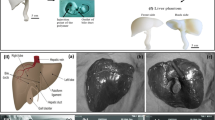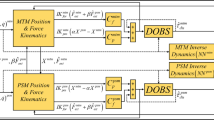Abstract
Purpose
The use of haptic (the sensing of touch) technology as an interactive tool for new diagnostic procedures is an important and interesting goal because of the potential benefits.
Materials and methods
We developed an algorithm for integration of haptic sensing in a medical 3D visualization environment. 3D reconstructions were generated from a stack of medical preoperative images. The innovation of the presented work is the improvement on the behavior of the haptic rendering over previous algorithms. First, the tool we developed for 3D reconstruction is presented. The classical pipeline for surface 3D reconstruction is reviewed from a parametric point of view. These parameters play an important role in the analysis of the haptic behavior. In addition, all the parameters of the reconstruction are accessible and can be modified on-line during the reconstruction procedure. Next, the software architecture used for the integration of the haptic devices is described. The haptic rendering algorithm is detailed, including the collision detection algorithm (a simple ray-tracing scheme programmed using VTK) that is used with the medical images.
Results
The results obtained by evaluation of the haptic algorithm’s behavior are presented, demonstrating acceptance of the interactive tool by medical professionals.
Conclusion
An improved method for haptic sensing and interaction in a 3D medical visualization environment is feasible and promises to improve image-guided interventions and minimally invasive surgery.
Similar content being viewed by others
References
Cleary K, Nguyen C (2001) State of art in surgical robotics: clinical applications and technology challenges. Comput Aided Surg 6(6): 312–328
Pott PP, Scharf H-P, Schwarz MLR (2005) Today’s state of the art in surgical robotics. Comput Aided Surg 10(2): 101–132. doi:10.1080/10929080500228753
Bartz D, Guvit O (2000) Haptic navigation in volumetric datasets. In PHANToM User Research Symposium, Zurich
Barbagli F, Prattichizzo D, Salisbury K (2004) Multi-contact haptic interaction with deformable objects: a multi-rate approach. Int J Robot Res
Liu A, Tendick F, Cleary K, Kaufmann C (2003) A survey of surgical simulation: applications, technology, and education. Presence 12(6). doi:10.1162/105474603322955905
Maintz JB, Viergever M (1998) A survey of medical image registration. Med Image Anal 2(1): 1–36
Schroeder W, Martin K, Lorensen B (2004) The Visualization Toolkit. An object oriented approach to 3D graphics. Kitware
Sensable Technologies OpenHaptics Toolkit 2.0. Sensable Tech Inc., 2005
Lorensen W, Cline H (1987) Marching cubes: a high resolution 3d surface construction algorithm. Comput Graph (ACM) 21(3): 163–169. doi:10.1145/37402.37422
Trolltech Ltd Webpage http://www.trolltech.com (last visited, February 2007)
Author information
Authors and Affiliations
Corresponding author
Rights and permissions
About this article
Cite this article
Sabater, J.M., García, N., Pérez, C. et al. Algorithm for haptic rendering of reconstructed 3D solid organs. Int J CARS 3, 387–393 (2008). https://doi.org/10.1007/s11548-008-0240-7
Received:
Accepted:
Published:
Issue Date:
DOI: https://doi.org/10.1007/s11548-008-0240-7




